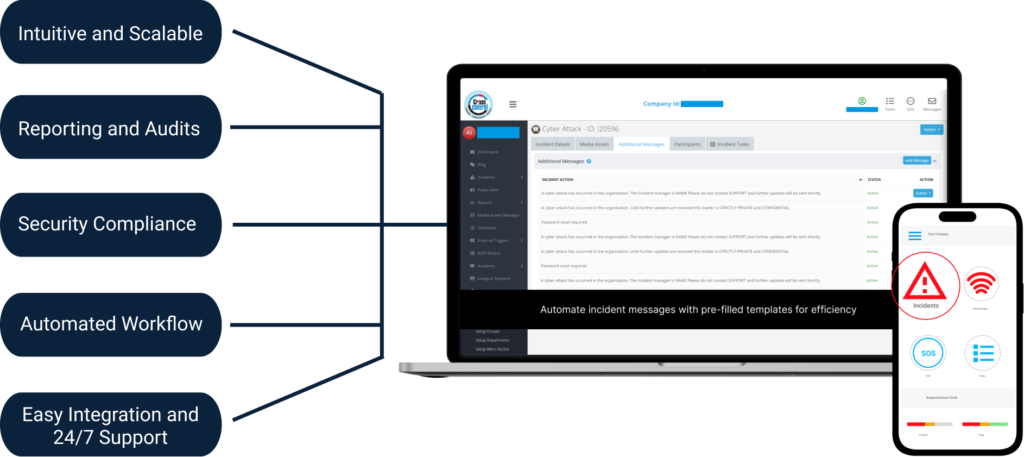Organisations face a constant barrage of potential disruptions – from natural disasters and cyberattacks to operational failures and disgruntled stakeholders. Navigating these crises effectively requires not only robust planning, but also the right tools to facilitate clear, coordinated communication. This is where emergency communication software emerges as a critical asset.
What is Emergency Communication Software?
Emergency communication software is a specialised platform designed to streamline the dissemination of critical information during crisis situations. It goes beyond traditional communication methods by offering a suite of features geared towards rapid, reliable, and multi-channel alerting.
Here’s a breakdown of some key functionalities:
- Multi-channel communication: Reach your audience across various channels – SMS, email, voice calls, push notifications, and even social media integrations – ensuring your message gets through regardless of individual preferences or accessibility limitations.
- Targeted messaging: Segment your audience based on location, role, or department, allowing for tailored communication that resonates with specific needs.
- Real-time updates: Provide continuous updates on the evolving situation, keeping everyone informed and fostering a sense of control.
- Two-way communication: Enable two-way communication channels, allowing for feedback, status updates, and real-time needs assessment from personnel on the ground.
- Collaboration tools: Facilitate collaboration between response teams through features like conference call bridges, task management modules, and shared resource repositories.
- Geolocation tracking: Track the location of key personnel, especially during emergencies where individual safety may be a concern.
- Incident reporting: Streamline incident reporting through user-friendly interfaces, enabling faster response times and improved data collection for future analysis.
How Emergency Communication Software Bolsters Crisis Management
Crisis management encompasses the entire lifecycle of a crisis event, from pre-planning and preparedness to response and recovery. Emergency communication software plays a vital role throughout this cycle:
- Preparation: Establish pre-configured communication plans for various scenarios, including templates for alerts and designated communication channels for different teams.
- Early Warning: Broadcast timely alerts to notify stakeholders of a potential or ongoing crisis, allowing for immediate action and mitigation efforts.
- Situational Awareness: Provide real-time updates on the evolving situation, keeping leadership informed and enabling them to make data-driven decisions.
- Resource Coordination: Coordinate response efforts through task management tools and facilitate communication between disparate teams working towards resolution.
- Public Relations: Disseminate clear and consistent information to the public or relevant stakeholders, minimising confusion and mitigating reputational damage.
- Recovery: Facilitate post-crisis communication efforts, keeping everyone informed on recovery progress and ensuring a smooth return to normalcy.
How Emergency Communication Software Enhances Incident Response
Effective incident response hinges on swift action, clear communication, and coordinated efforts. Emergency communication software empowers organisations to optimise their incident response capabilities:
- Rapid Response Initiation: Alert designated response teams immediately, minimising time wasted in information dissemination and enabling a faster first response.
- Improved Accountability: Assign tasks and track progress within the platform, ensuring clarity of roles and responsibilities for each individual involved.
- Enhanced Situational Awareness: Provide a central hub for real-time information sharing about the incident, fostering a holistic understanding of the situation for all response teams.
- Streamlined Communication: Maintain clear communication channels within response teams and with external stakeholders, minimising confusion and fostering a unified response effort.
- Documentation and Learning: Capture incident data and communication records within the platform, facilitating a thorough debriefing process for future improvement.
How Poor Communication Can Cripple Your Response
The absence of a robust emergency communication system can have severe consequences during a crisis:
- Delayed Response: Without efficient communication, valuable time is lost notifying and mobilising response teams, potentially exacerbating the crisis.
- Misinformation and Confusion: A lack of clear and consistent communication can breed confusion and misinformation, hindering effective response efforts and jeopardising public safety.
- Wasted Resources: Without proper coordination, resources and personnel may be misallocated, hampering the overall response and recovery efforts.
- Reputational Damage: Ineffective communication during a crisis can erode public trust and damage an organisation’s reputation.
How Crises Control Can Help

Crises Control offers a comprehensive emergency communication software solution designed to empower organisations to navigate any crisis with confidence. Here’s what sets us apart:
- Intuitive and Scalable Platform: Our user-friendly platform simplifies communication workflows, enabling even non-technical users to send out critical alerts and manage incidents effectively.
- Feature-Rich Functionality: Our software boasts a comprehensive suite of features, encompassing multi-channel communication, real-time updates, task management, location tracking, and more.
- Advanced Reporting and Analytics: Go beyond basic data capture with our robust reporting and analytics tools. Generate insightful reports to identify trends, measure response effectiveness, and continuously improve your crisis management strategies.
- Security and Compliance: We understand the importance of data security, especially during sensitive crisis situations. Crises Control prioritises user data security by adhering to the highest industry standards and compliance regulations.
- Automated Workflows: Streamline communication workflows with customisable automation features. Automate routine tasks like alert escalation or incident reporting, freeing up your team to focus on critical decision-making.
- Integrations: Seamlessly integrate Crises Control with your existing communication platforms and tools, such as HR systems, building security systems, and mass notification systems, creating a centralised hub for all crisis-related communication.
- Dedicated Customer Support: Our dedicated customer support team is available 24/7 to provide ongoing assistance, answer your questions, and ensure you maximise the value of your investment in Crises Control.
Investing in Resilience: The Value Proposition of Emergency Communication Software
The benefits of implementing emergency communication software extend far beyond crisis mitigation. It fosters a culture of preparedness and resilience within your organisation, enabling you to:
- Enhance Business Continuity: By minimising disruption and ensuring a rapid response, emergency communication software safeguards your business continuity and minimises potential financial losses.
- Improve Employee Safety: Real-time alerts and two-way communication channels ensure employee safety during emergencies by providing timely evacuation instructions and enabling them to report on their situation.
- Strengthen Public Perception: Clear and consistent communication during a crisis demonstrates transparency and builds public trust, ultimately safeguarding your organisation’s reputation.
- Refine Response Strategies: Incident data captured within the platform allows for thorough post-crisis analysis, enabling you to identify areas for improvement and refine your response strategies for future events.
Taking the Next Step
Crises happen. But with the right tools and strategies in place, you can navigate them effectively, minimising disruption and safeguarding your organisation’s reputation.
Ready to bolster your crisis management and incident response capabilities?
Contact Crises Control today for a free demo of our emergency communication software and discover how we can help your organisation weather any storm.
In addition to the free demo, Crises Control also offers a library of valuable resources, including:
- Webinars: Stay informed with industry insights and best practices through our informative webinars on crisis communication and emergency preparedness.
- Case Studies: Learn from real-world examples of how organisations have successfully leveraged emergency communication software to overcome crisis situations.
- Blog Articles: Gain valuable insights on various aspects of crisis management, incident response, and communication best practices through our informative blog content.
By investing in emergency communication software and partnering with a trusted advisor like Crises Control, you can equip your organisation with the tools and expertise needed to navigate any crisis with confidence.
Request a Free Demo
Interested in our Emergency Communication Software?
FAQs
1. What is emergency communication software and how does it differ from traditional methods?
Emergency communication software is a specialised platform that streamlines critical information flow during crises. It goes beyond emails or phone calls by offering multi-channel communication (SMS, push notifications), real-time updates, two-way communication, and features like task management and location tracking.
2. How can emergency communication software help with crisis management?
This software empowers organisations throughout the crisis lifecycle. It aids in pre-planning with communication templates, facilitates early warnings, boosts situational awareness with real-time updates, and helps coordinate response efforts. It also supports public relations by ensuring clear, consistent messaging and streamlines post-crisis communication.
3. What are the benefits of emergency communication software for incident response?
Effective incident response relies on swift action and clear communication. This software enables faster response initiation by immediately alerting designated teams, improves accountability with task tracking, and fosters a unified response through streamlined communication channels. Additionally, it facilitates data capture for post-incident analysis and future improvement.
4. What happens if my organisation doesn’t have emergency communication software?
The absence of a robust system can have severe consequences. Delays in notifying and mobilising response teams can worsen a crisis. Lack of clear communication can breed confusion and hinder response efforts. Additionally, it can lead to wasted resources, public mistrust, and reputational damage.
5. Why choose Crises Control for our emergency communication software needs?
Crises Control offers a user-friendly, feature-rich platform with functionalities like multi-channel communication, real-time updates, task management, and more. We go beyond basic features with advanced reporting, robust security, and automation options. Additionally, our software integrates seamlessly with existing systems and provides 24/7 dedicated customer support.







